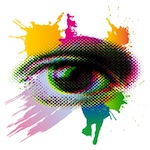9 Ways to Leverage Visual Storytelling Today (and the Future)
Your brain “reads” images faster than words alone. And for hospital and healthcare storytelling, it’s a powerful way to communicate compelling and more memorable ideas in branding, marketing and advertising. Show before you tell.
As you and I spin through the blaze of thousands of marketing messages that assault our brains each day, the ones that are purely text are rarely noticed.
Consider your Twitter stream as one example. Tweets with a picture or graphic break the squelch on scanner-mode brain, at least momentarily. The Tweets in straight text are mentally dismissed as a gray blur between the obviously more valuable, and graphically highlighted ones.
The same is true (generally) for the various other social media, advertising messages and the thousands of marketing messages that demand our attention.
Technology and contemporary marketing methods—the battle for a share of the consumer’s mind—has trained our brain’s attention gateway to sort and filter inbound messages according to a hierarchy. Visual stuff is more important than text alone, just as audio-plus-visual input is higher on the totem than either stimulus alone. And so on.
“Getting through the clutter,” for effective healthcare and hospital marketing and public relations is complicated and challenging. But visual storytelling is a powerful tool for communications professionals that can deliver greater impact and results. Consider this checklist of (sometimes overlapping) options:
Text as graphics: Notwithstanding our preamble, bold use of text (letterforms) can form an attention-getting graphic or super-graphic.

Charts and graphs: Complex information is more easily interpreted when distilled to a chart. Excel and other common software will draw them in a snap.

Infographics: Audiences love informative graphics that quickly condense data, text and images to digestible images. What’s more, clever and interesting infographics are easily sharable.

Video (short form): Both Vine and Instagram are quick and easy to use. But being creative and interesting in a few seconds is the challenge.
Video (live streaming): Periscope and Meerkat have jumped into the spotlight as live and recorded video streaming…of anything, from anywhere. Healthcare marketers are finding imaginative uses for real-time video that communicates and educates.
Virtual and Augmented Reality: VR and AR are on the not-so-distant horizon. It’s hard to say exactly when the march of technology will bring the immersive, multimedia VR experience to mainstream use. With a solid foothold in popular gaming applications, VR, AR and even 3D experiences are certain to move to medical, scientific and healthcare messaging.
Visual storytelling for hospital, healthcare and medical marketing applications is, in many respects, already a major tool for communicators. What’s more, visuals of all sorts are commonplace and growing in popularity.
Tell us: How are you using visuals to leverage your marketing messages…today and in the future?
Related Articles:
Picture This: Using the Explosive Trend to Visuals in Social Media
Mastering the Art of Healthy Storytelling for Better Physician Marketing
6 Secrets: Making Your Hospital Storytelling Great
Keeping Up with a Picture Perfect World for Healthcare Marketing










